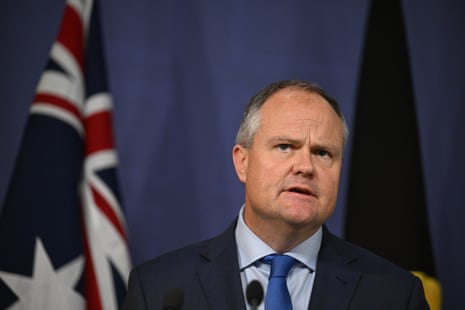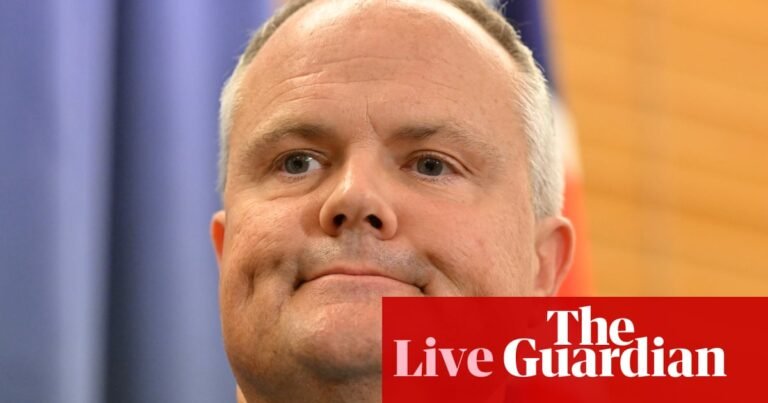Coalition says unemployment numbers ‘not what Labor promised’
Tom McIlroy
The Coalition blamed Labor for today’s surprise uptick in unemployment, saying the increase to 4.3% in June shows the Albanese government is “failing to manage the economy”.
Markets had been expecting unemployment to remain steady at 4.1% for the sixth consecutive month. Instead, the increase puts the jobless rate at its highest level since 2021. The shadow treasurer, Ted O’Brien, said working Australians were finding it harder to get a job under Labor:
The unemployment rate is now at its highest level since November 2021, with 34,000 more Australians out of work this month alone. This is not what Labor promised.
While Australians are working hard just to keep up with the cost of living, Labor’s economic mismanagement is making it even harder for households to make ends meet.

O’Brien accused the government of being “heavy on spin and light on delivery”.
We know people are doing it tough and we need to ensure our policies reflect the aspirations of everyday Australians who want more secure, well-paid jobs.
Key events
Anthony Albanese denied his trip to China had been “indulgent,” after opposition frontbencher James Paterson criticised the prime minister for visiting the Great Wall of China and meeting pandas in Chengdu.
The visit had focused on building diplomatic relations, Albanese said, pointing to the economic benefits of stronger ties between China and Australia. He told reporters:
The Great Wall of China symbolises the extraordinary history and culture here in China, and showing a bit of respect to people never cost anything. But you know what it does? It gives you a reward.
Paterson had criticised Albanese’s focus on “a Gough Whitlam history tour” of China and a lack of concrete diplomatic outcomes. Asked whether he had past prime ministers’ visits to China in mind during the visit, Albanese said:
“I was thinking more of them than I was of James Paterson, it’s fair to say. But it’s also the case I was thinking of how worthwhile it is for Australia as well. Those pictures go to 27 million people, potentially, in Australia. They go to over a billion people in China … who increasingly are rising up the income ladder and are potential tourists and therefore job creators in Australia.
If James Patterson doesn’t understand that, then he doesn’t understand much.
Albanese praises Xi after ‘very successful visit’ to China
Australia is focused on “today and tomorrow rather than the past” in its relationship with China, Anthony Albanese has said, as he approaches the end of what he described as a “very successful visit” to China.
Asked about Chinese leaders’ references to past difficulties in the relationship between the two countries, Albanese said he was looking to the future:
Overwhelmingly what we discuss is moving forward is issues of today and tomorrow rather than the past. And it’s something that I very much have concentrated on. What I speak about is the potential that’s there to grow the relationship, to develop further economic ties.
Speaking after a medical technology luncheon in Chengdu, the prime minister pointed to the signing of two-way trade agreements and two way tourism agreements and his meetings with China’s top leadership as evidence of his success.
Albanese praised China’s Xi Jinping, who he said had congratulated him on his election win earlier this year:
President Xi is warm and engaging. We have had four bilateral meetings but have also engaged at other times as well on an informal basis. That’s a positive thing. President Xi sent a very warm message of congratulations, as did other leaders after the May 3rd election.

Luca Ittimani
Thanks for staying with us this Thursday. I’ll be taking you through the afternoon’s news.

Nick Visser
That’s all for me, thanks for sticking with us through the start of the day’s news. Luca Ittimani will take the reins from here.

Tom McIlroy
Chalmers says unemployment figures show economy ‘not immune’ from uncertainty
The treasurer, Jim Chalmers, weighed in on today’s unemployment numbers from the G20 meeting of finance ministers and central bank governors in Durban, South Africa.
He says the increase in the unemployment rate to 4.3% in June is “the inevitable consequence of economic uncertainty and volatility around the world and the ongoing impact of higher interest rates.” Chalmers added:
Despite all the challenges coming at us, Australia’s unemployment rate remains historically low and we’re pleased to see the participation rate remains near-record highs.
The ongoing resilience in our labour market over the past three years remains one of our best defences against the volatile global economic conditions we face, which is a big focus of my discussions here at the G20.
The Australian economy is not immune from global uncertainty but we are well‑placed and well‑prepared to face the challenges ahead.
Coalition says unemployment numbers ‘not what Labor promised’

Tom McIlroy
The Coalition blamed Labor for today’s surprise uptick in unemployment, saying the increase to 4.3% in June shows the Albanese government is “failing to manage the economy”.
Markets had been expecting unemployment to remain steady at 4.1% for the sixth consecutive month. Instead, the increase puts the jobless rate at its highest level since 2021. The shadow treasurer, Ted O’Brien, said working Australians were finding it harder to get a job under Labor:
The unemployment rate is now at its highest level since November 2021, with 34,000 more Australians out of work this month alone. This is not what Labor promised.
While Australians are working hard just to keep up with the cost of living, Labor’s economic mismanagement is making it even harder for households to make ends meet.
O’Brien accused the government of being “heavy on spin and light on delivery”.
We know people are doing it tough and we need to ensure our policies reflect the aspirations of everyday Australians who want more secure, well-paid jobs.

Josh Taylor
Meta argues its AI needs personal information from social media posts to learn ‘Australian concepts’
Meta has urged the Australian government not to make privacy law changes that would prevent the company using personal information taken from Facebook and Instagram posts to train its AI, arguing the AI needs to learn “how individuals discuss Australian concepts”.
In a submission to the Productivity Commission’s review on harnessing data and digital technology, published this week, the parent company of Facebook, Instagram and WhatsApp argued for a “global policy alignment” in the Albanese government’s pursuit of privacy reform in the AI age.
Meta said generative AI models “require large and diverse datasets” and cannot rely on synthetic data – data generated by AI alone. The company said available databases, such as Australian legislation, were limited in what they could offer AI compared to datasets containing personal information.
Meta has been training its AI, Llama, on publicly accessible Facebook and Instagram posts since last year. The company was ordered to stop training its data on users’ posts for those based in Europe, and Meta ultimately gave users in the EU an opt-out option.
Read more:

Tom McIlroy
Should Jim Chalmers’ productivity roundtable have voice representing the environment?
The Australian Conservation Foundation wants voices representing the environment to have a seat at the table in the Albanese government’s upcoming productivity summit.
The treasurer, Jim Chalmers, will convene three days of talks with business leaders, trade unions and eminent Australians next month, for discussions about reforms to the economy and Labor’s second term agenda.
ACF’s nature program manager, Basha Stasak, said the biggest threat to Australia’s future productivity comes from the destruction of nature. The group wants the environment minister, Murray Watt, to proceed with planned changes to the Environment Protection and Biodiversity Conservation Act, delayed in the last parliament over political concerns by Labor. Stasak said:
Repairing Australia’s broken nature protection law is one critical thing the Albanese government can do to boost productivity. Research by ACF shows roughly half Australia’s GDP – 49% or $896 billion – has a moderate to very high direct dependence on nature.
It will be important for the upcoming productivity roundtable to consider the importance of healthy nature to a healthy economy.
So far, invitations to the summit in the cabinet room include the Productivity Commission, the ACTU, the Australian Chamber of Commerce and Industry, the Business Council and the Australian Council of Social Service.
Chalmers is due to announce more invitations soon.
Bearded dragons outfitted with tiny backpacks lead to surprise finding
New research, gathered with tiny fitness trackers outfitted on Australian central bearded dragons, found lizards who ran the fastest were more likely to die than their slower compatriots, a surprising finding at odds with scientists’ assumptions.
The study, published today and led by Dr Kristoffer Wild from the University of Melbourne, saw several bearded dragons tracked with “wearable smart devices” that contained tiny accelerometers and temperature-sensing radio transmitters.
While many animals are assumed to do better in the wild if they are faster than their kin, Wild’s research showed bearded dragons had a greater risk of mortality if they were faster than others. Wild said in a media release:
What we believe is happening is that speedy lizards are engaging in riskier behaviours, such as moving around more openly and frequently, making them vulnerable to predators like birds and cats.
We found that increased risk was especially pronounced during spring, so this would make sense with dragons moving around a lot more looking for mates.
Albanese wraps China tour touting ongoing cooperation to build ‘healthier, more prosperous future’
The prime minister, Anthony Albanese, just spoke in Chengdu, China, as he wraps up his visit to the country. He gave a short speech praising cooperation and trade between the two nations and said collaboration between Chinese and Australian firms would serve as a model for further cooperation and growth. He said:
Governments can build and expand this architecture of cooperation. Yet, ultimately, it is people who give it strength and life. Our partnership works because you work together. You engage. You share and you shape ideas. …
The positive difference that all of you have made to people’s lives is powerful proof of what can be achieved when Australia and China work together in the best interests of all of our citizens. I should add, as well, that that is in the interests of the global community, as well as our two nations. Let us continue to build a healthier, more prosperous future for the people of Australia and the people of the People’s Republic of China.
The humpback whale that swam to Circular Quay, delighting ferry passengers, has left Sydney Harbour

Natasha May
A young humpback whale who wandered from its usual migratory route right up to Sydney’s Harbour Bridge has left the harbour.
The sub-adult whale left the body of water, with no sign of it on Thursday morning, a government source told Guardian Australia.
The whale delighted onlookers and experts after it was first spotted swimming at Circular Quay on Wednesday morning before moving east on what experts tracking the mammal called its “full harbour experience”.
Dr Vanessa Pirotta, a whale expert on board a New South Wales Maritime boat on Wednesday, confirmed the whale was “not in distress, quite the opposite”. It appeared to be inquisitive and relaxed, visiting various harbourside locations, she said.
The whale’s appearance was a “reminder that Sydney Harbour is very wild”.
Read more:
Up to 7 metre waves forecast in parts of Australia as cold fronts create huge swells
Weatherzone reports cold fronts to the south and southwest of Australia have been generating gale to storm-force winds over the last few days across a large area of ocean. Seas exceeding 10 metres have been generated within the core of the storm, with some waves topping 5 metres extending west of Tasmania to nearly Africa.
Significant waves of up to 6 metres are expected to be present off the south-west corner of Western Australia until early Saturday, with some waves exceeding that 6 metre mark on Friday morning.
Parts of South Australia, southwest Victoria and western Tasmania are also expected to see wave heights more than 4.5 metres on Thursday. The exposed west coast of Tasmania could see increased swells, possibly up to 7 metres, on Saturday.


